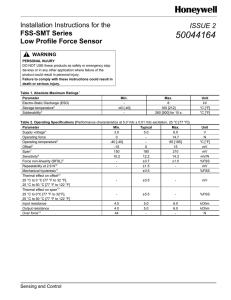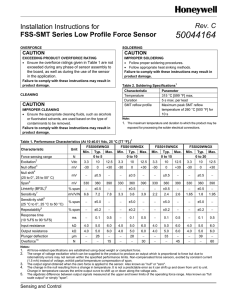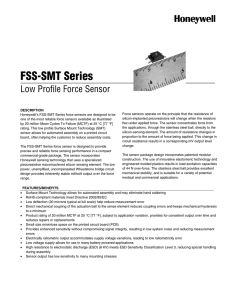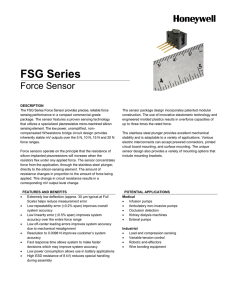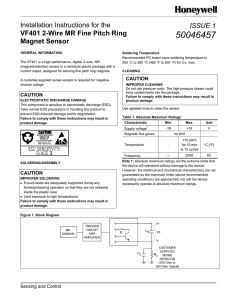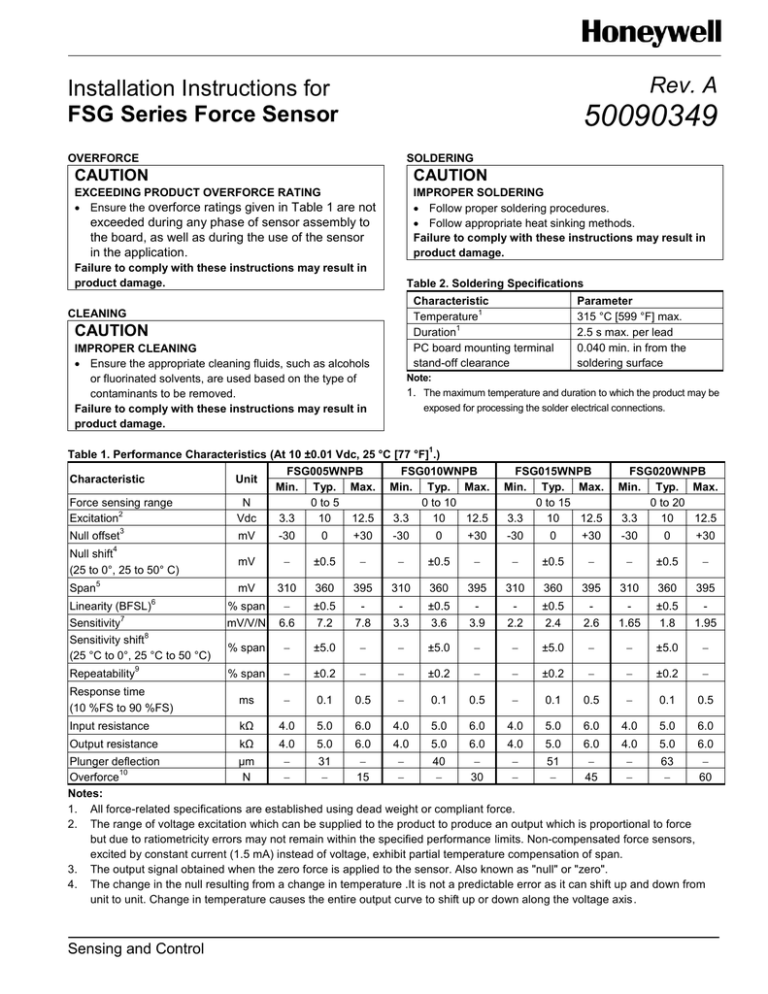
Rev. A
Installation Instructions for
FSG Series Force Sensor
50090349
OVERFORCE
SOLDERING
CAUTION
CAUTION
EXCEEDING PRODUCT OVERFORCE RATING
Ensure the overforce ratings given in Table 1 are not
IMPROPER SOLDERING
Follow proper soldering procedures.
Follow appropriate heat sinking methods.
Failure to comply with these instructions may result in
product damage.
exceeded during any phase of sensor assembly to
the board, as well as during the use of the sensor
in the application.
Failure to comply with these instructions may result in
product damage.
Table 2. Soldering Specifications
Characteristic
1
Temperature
1
Duration
PC board mounting terminal
stand-off clearance
CLEANING
CAUTION
IMPROPER CLEANING
Ensure the appropriate cleaning fluids, such as alcohols
or fluorinated solvents, are used based on the type of
contaminants to be removed.
Failure to comply with these instructions may result in
product damage.
Parameter
315 °C [599 °F] max.
2.5 s max. per lead
0.040 min. in from the
soldering surface
Note:
1. The maximum temperature and duration to which the product may be
exposed for processing the solder electrical connections.
1
Table 1. Performance Characteristics (At 10 ±0.01 Vdc, 25 °C [77 °F] .)
N
Vdc
FSG005WNPB
Min. Typ. Max.
0 to 5
3.3
10
12.5
FSG010WNPB
Min. Typ. Max.
0 to 10
3.3
10
12.5
FSG015WNPB
Min. Typ. Max.
0 to 15
3.3
10
12.5
FSG020WNPB
Min. Typ. Max.
0 to 20
3.3
10
12.5
mV
-30
0
+30
-30
0
+30
-30
0
+30
-30
0
+30
mV
±0.5
±0.5
±0.5
±0.5
Characteristic
Unit
Force sensing range
2
Excitation
3
Null offset
4
Null shift
(25 to 0°, 25 to 50° C)
Span
5
Linearity (BFSL)
6
7
Sensitivity
8
Sensitivity shift
(25 °C to 0°, 25 °C to 50 °C)
mV
310
360
395
310
360
395
310
360
395
310
360
395
% span
mV/V/N
6.6
±0.5
7.2
7.8
3.3
±0.5
3.6
3.9
2.2
±0.5
2.4
2.6
1.65
±0.5
1.8
1.95
% span
±5.0
±5.0
±5.0
±5.0
% span
±0.2
±0.2
±0.2
±0.2
Response time
(10 %FS to 90 %FS)
ms
0.1
0.5
0.1
0.5
0.1
0.5
0.1
0.5
Input resistance
kΩ
4.0
5.0
6.0
4.0
5.0
6.0
4.0
5.0
6.0
4.0
5.0
6.0
Output resistance
kΩ
4.0
5.0
6.0
4.0
5.0
6.0
4.0
5.0
6.0
4.0
5.0
6.0
Repeatability
9
Plunger deflection
µm
31
40
51
63
10
Overforce
N
15
30
45
60
Notes:
1. All force-related specifications are established using dead weight or compliant force.
2. The range of voltage excitation which can be supplied to the product to produce an output which is proportional to force
but due to ratiometricity errors may not remain within the specified performance limits. Non-compensated force sensors,
excited by constant current (1.5 mA) instead of voltage, exhibit partial temperature compensation of span.
3. The output signal obtained when the zero force is applied to the sensor. Also known as "null" or "zero".
4. The change in the null resulting from a change in temperature .It is not a predictable error as it can shift up and down from
unit to unit. Change in temperature causes the entire output curve to shift up or down along the voltage axis .
Sensing and Control
FSG Series Force Sensor
Rev. A
50090349
5.
The algebraic difference between output signals measured at the upper and lower limits of the operating force range. Also
known as "full scale output" or simply "span".
6. The maximum deviation of product output from a straight line fitted to output measured over the operating forc e range.
The straight line through a set of points which minimizes the sum of the square of the deviations of each of the points from
the straight line.
7. The ratio of output signal change to the corresponding input force change. Sensitivity is determined by computing the ratio
of span to the specified operating force range multiplied by the supply voltage being used.
8. The maximum deviation in sensitivity due to changes in temperature over the operating temperature range, relative to
sensitivity measured at 25 °C.
9. The maximum difference between output readings when the same force is applied consecutively, under the same
operating conditions, with force approaching from the same direction within the operating force range.
10. The maximum force which may safely be applied to the product for it to remain in specification once force is returned to
the operating force range. Exposure to higher forces may cause permanent damage to the product. Unless otherwise
specified this applies to all temperatures within the operating temperature range.
Table 3. Environmental Specifications
Characteristic
Parameter
1
Operating temperature
-40 °C to 85 °C [-40 °F to 185 °F]
Shock
qualification tested to 150 g
Vibration
qualification tested to 0 to 2 kHz, 20 g sine
2
MCTF (Mean Cycles to Failure)
20 million at 25 °C [77 °F]
Output ratiometric
within supply range
Notes:
1. The temperature range over which the product may safely be exposed without excitation or force applied. Under these
conditions the product will remain in specification after excursion to any temperatures in this range. Exposure to temperatures
beyond this range may cause permanent damage to the product.
2. MCTF is a basic measure of reliability for a non-repairable device. It is the mean number of cycles to maximum operating
force over which a sensor can be expected to operate until failure. The mean value is determined statistically from a
probability distribution for failures based upon test data. MCTF may vary depending on the specific application in which a
sensor is utilized.
1
Table 4. Absolute Maximum Ratings
Characteristic
Parameter
2
Storage temperature
-40 °C to 100 °C [-40 °F to 212 °F]
ESD
Meets ESD Sensitivity Classification Level 3B
Notes:
1. The extreme limits that the product can withstand without damage to the product.
2. The temperature range over which the product may safely be exposed without excitation or force applied. Under these
conditions, the product will remain in the specification after excursions to any temperature in this range. Exposure to
temperatures beyond this range may cause permanent damage to the product.
Figure 1. Excitation Schematic (Excitation 5 Vdc Typ., 6 Vdc max.)
1. Circled numbers refer to sensor terminals (pins).
Pin 1 = Supply Vs (+), Pin 2 = Output Vo (+), Pin 3 = Ground Vg (-), Pin 4 = Output Vo (-)
1
2. The force sensor may be powered by voltage or current. Maximum supply voltage is
+
not to exceed 6 V. Maximum supply current is not to exceed 1.2 mA. Power is applied
Vs
+ Vo 2
4
across Pin 1 and Pin 3.
3. The sensor output should be measured as a differential voltage across Pin 2 and
Pin 4 (Vo = Vo(+)-Vo(-)). The output is ratiometric to the supply voltage. Shifts in
3
supply voltage will cause shifts in output. Neither Pin 2 nor Pin 4 should be tied to
ground or voltage supply.
2 Honeywell Sensing and Control
FSG Series Force Sensor
Rev. A
50090349
Figure 2. Sensor Mounting Dimensions (For reference only: mm/[in].)
FSG005WNPB, FSG010WNPB. FSG015WNPB, FSG020WNPB
Force Sensing Range
Actuator Height
0 to 5 N
0 to 10 N
1,33 ±0.28 mm
[0.05 ±0.01 in]
0 to 15 N
1,31 ±0.27 mm
[0.05 ±0.01 in]
0 to 20 N
Figure 3. Plastic Mounting Bracket Mounting Dimensions (For reference only: mm/[in].)
PC15132
Bracket With and Without Sensor
3 Honeywell Sensing and Control
FSG Series Force Sensor
WARNING
PERSONAL INJURY
DO NOT USE these products as safety or emergency
stop devices or in any other application where failure of
the product could result in personal injury.
Failure to comply with these instructions could result in
death or serious injury.
WARRANTY/REMEDY
Honeywell warrants goods of its manufacture as being free of
defective materials and faulty workmanship. Honeywell’s
standard product warranty applies unless agreed to otherwise
by Honeywell in writing; please refer to your order
acknowledgement or consult your local sales office for specific
warranty details. If warranted goods are returned to Honeywell
during the period of coverage, Honeywell will repair or replace,
at its option, without charge those items it finds defective. The
foregoing is buyer’s sole remedy and is in lieu of all other
warranties, expressed or implied, including those of
merchantability and fitness for a particular purpose. In no
event shall Honeywell be liable for consequential, special,
or indirect damages.
Rev. A
SALES AND SERVICE
Honeywell serves its customers through a worldwide network
of sales offices, representatives and distributors. For
application assistance, current specifications, pricing or name
of the nearest Authorized Distributor, contact your local sales
office or:
E-mail: info.sc@honeywell.com
Internet: sensing.honeywell.com
Phone and Fax:
Asia Pacific
+65 6355-2828
+65 6445-3033 Fax
Europe
+44 (0) 1698 481481
+44 (0) 1698 481676 Fax
Latin America
+1-305-805-8188
+1-305-883-8257 Fax
USA/Canada
+1-800-537-6945
+1-815-235-6847
+1-815-235-6545 Fax
While we provide application assistance personally, through
our literature and the Honeywell web site, it is up to the
customer to determine the suitability of the product in the
application.
Specifications may change without notice. The information we
supply is believed to be accurate and reliable as of this printing.
However, we assume no responsibility for its use.
Sensing and Control
Honeywell
1985 Douglas Drive North
Golden Valley, MN 55422
sensing.honeywell.com
50090349
50090349-A-EN
August 2013
Copyright © 2013 Honeywell International Inc. All rights reserved.

